- Prerequisites
- Step 1. Install Java 17 (OpenJDK)
- Step 2. Trendz Analytics service installation
- Step 3. Obtain and configure license key
- Step 4. Configure connection with ThingsBoard Platform
- Step 5. Configure Trendz database
- Step 6. Run installation script
- Step 7. Start Trendz service
- Step 8. Install Trendz Python Executor
- Post-installation steps
- Troubleshooting
- Windows firewall settings
- Next steps
This guide explains how to install Trendz Analytics on Windows 10 or 11 (32-bit/64-bit).
Important note before proceeding with Windows installation
Certain Trendz Analytics features like predictions, metric explorations, and Python calculation fields require a Python executor.
The python executor runs only via Docker. Even on Windows, Docker is essential to fully utilize all Trendz features.
We recommend following the Docker (Windows) installation guide and using the Docker installation instead of Windows.
Proceed here only if you have a compelling reason to use a combined Windows + Docker setup.
Prerequisites
Hardware requirements depend on amount of analyzed data and amount of devices connected to the system. To run Trendz Analytics on a single machine you will need at least 1Gb of free RAM.
In small and medium installations Trendz can be installed on the same server with ThingsBoard.
Step 1. Install Java 17 (OpenJDK)
ThingsBoard service is running on Java 17. Follow this instructions to install OpenJDK 17.
- Visit Open JDK Download Page. Go to “Other platforms and versions”, select “Operating System” as “Windows”, “Architecture” as “x64”, “Version” as “17 - LTS” and download JDK .msi package.
- Run the downloaded MSI package and follow the instructions. Make sure you have selected “Add to PATH” and “Set JAVA_HOME variable” options to “Will be installed on local hard drive” state.
- Visit PostgreSQL JDBC Download Page to download PostgreSQL JDBC Driver. Choose the latest available option.
- Create the folder C:\Program Files\JDBC and copy downloaded file there. Then, add a new global variable - run PowerShell as an administrator and execute the following command. Do not forget to change “postgresql-42.2.18.jar” in the command to match the downloaded version.
1
[System.Environment]::SetEnvironmentVariable("CLASSPATH", '.;"C:\Program Files\JDBC\postgresql-42.2.18.jar"', [System.EnvironmentVariableTarget]::Machine)
You can check the installation using the following command (using Command Prompt):
1
java -version
Expected command output is:
1
2
3
4
C:\Users\User>java -version
openjdk version "17.x.xx"
OpenJDK Runtime Environment Temurin-17.x.xx (...)
OpenJDK 64-Bit Server VM Temurin-17.x.xx (...)
Step 2. Trendz Analytics service installation
Download and extract the package.
1
https://dist.thingsboard.io/trendz-windows-1.14.0.zip
Note: We assume you have extracted Trendz package to default location: C:\Program Files (x86)\trendz
Step 3. Obtain and configure license key
We assume you have already chosen subscription plan for Trendz and have license key. If not, please get your Free Trial license before you proceed. See How-to get pay-as-you-go subscription for more details.
Once you get the license secret, you should put it to the trendz configuration file.
Open the Notepad or other editor as administrator user (right click on the app icon and select “Run as administrator”).
Open the following file for editing (select “All Files” instead of “Text Documents” in file choosing dialog, the encoding is UTF-8):
1
C:\Program Files (x86)\trendz\conf\trendz.yml
Scroll to the bottom of the file and locate the following configuration block:
1
2
license:
secret: "${TRENDZ_LICENSE_SECRET:YOUR_LICENSE_SECRET_HERE}" # license secret obtained from ThingsBoard License Portal (https://license.thingsboard.io)
Step 4. Configure connection with ThingsBoard Platform
You can connect Trendz Analytics to the ThingsBoard Community Edition or ThingsBoard Professional Edition.
Open the Notepad or other editor as administrator user (right click on the app icon and select “Run as administrator”).
Open the following file for editing (select “All Files” instead of “Text Documents” in file choosing dialog, the encoding is UTF-8):
1
C:\Program Files (x86)\trendz\conf\trendz.yml
Add ThingsBoard REST API URL that would be used for communicating with ThingsBoard Platform. In most cases, when Trendz installed in the same server with ThingsBoard, API_URL would be http://localhost:8080. Otherwise you should use ThingsBoard domain name.
1
tb.api.url: "${TB_API_URL:http://localhost:8080}"
Step 5. Configure Trendz database
Trendz uses PostgreSQL as a database. You can install PostgreSQL on the same serverfor Trendz or use managed PostgreSQL service from your cloud vendor.
PostgreSQL Installation
Download the installation file (PostgreSQL 12.17 or newer releases) here and follow the installation instructions.
During PostgreSQL installation, you will be prompted for superuser (postgres) password. Don’t forget this password. It will be used later. For simplicity, we will substitute it with “postgres”.
Create Database for Trendz
Once installed, launch the “pgAdmin” software and login as superuser (postgres). Open your server and create database “trendz” with owner “postgres”.
Configure database connection for Trendz
Open the Notepad or other editor as administrator user (right click on the app icon and select “Run as administrator”).
Open the following file for editing (select “All Files” instead of “Text Documents” in file choosing dialog, the encoding is UTF-8):
1
C:\Program Files (x86)\trendz\conf\trendz.yml
and locate “datasource” block. Replace SPRING_DATASOURCE_URL, SPRING_DATASOURCE_USERNAME and SPRING_DATASOURCE_PASSWORD properties with valid values. Don’t forget to replace “postgres” with your real postgres user password:
1
2
3
4
5
6
7
datasource:
driverClassName: "${SPRING_DRIVER_CLASS_NAME:org.postgresql.Driver}"
url: "${SPRING_DATASOURCE_URL:jdbc:postgresql://localhost:5432/trendz}"
username: "${SPRING_DATASOURCE_USERNAME:postgres}"
password: "${SPRING_DATASOURCE_PASSWORD:postgres}"
hikari:
maximumPoolSize: "${SPRING_DATASOURCE_MAXIMUM_POOL_SIZE:5}"
Step 6. Run installation script
Launch windows shell (Command Prompt) as Administrator. Change directory to your Trendz installation directory.
Execute install.bat script to install Trendz as a Windows service. This means it will be automatically started on system startup. Similar, uninstall.bat will remove Trendz from Windows services. The output should be similar to this one:
1
2
3
4
5
6
7
C:\Program Files (x86)\trendz>install.bat
Detecting Java version installed.
CurrentVersion 11
Java 11 found!
Installing Trendz Analytics...
...
Trendz Analytics installed successfully!
Step 7. Start Trendz service
Now let’s start the Trendz service! Open the command prompt as an Administrator and execute the following command:
1
net start trendz
Expected output:
1
2
The Trendz Analytics service is starting.
The Trendz Analytics service was started successfully.
In order to restart the Trendz service you can execute following commands:
1
2
net stop trendz
net start trendz
Once started, you will be able to open Web UI using the following link:
1
http://localhost:8888/trendz
Note: If Trendz installed on a remote server, you have to replace localhost with the public IP address of the server or with a domain name. Also, check that port 8888 opened for public access.
Authentication
For first authentication you need to use Tenant Administrator credentials from your ThingsBoard
Trendz uses ThingsBoard as an authentication service. During first sign in ThingsBoard service should be also available to validate credentials.
Step 8. Install Trendz Python Executor
To utilize all Trendz capabilities, such as Trendz Python Calculation Fields or Prediction Models, it is essential to install an additional service: the Trendz Python Executor, which can securely run Python code.
You can learn more about how to install it here.
Post-installation steps
It is essential to follow these instructions to fully use all features, such as saving telemetry to ThingsBoard and adding Trendz views to dashboards.
Troubleshooting
The log files are located in logs folder (“C:\Program Files (x86)\trendz\logs” in our case).
The trendz.log file should contain following line:
1
YYYY-MM-DD HH:mm:ss,sss [main] INFO o.t.t.TrendzApplication - Started TrendzApplication in x.xxx seconds (JVM running for x.xxx)
In case of any unclear errors, use general troubleshooting guide or contact us.
Windows firewall settings
In order to have external access to Trendz Web UI you need to create a new inbound rule with Windows Firewall with Advanced Security.
- Open “Windows Firewall” from “Control Panel”:
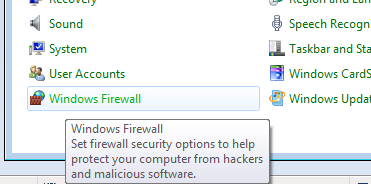
- Click “Advanced settings” on the left panel:
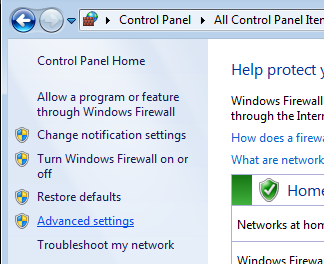
- Select “Inbound Rules” on the left panel, then click “New Rule…” on the right “Actions” panel:

- Now new “New Inbound Rule Wizard” window will open. On the first step “Rule Type” select “Port” option:

- On the “Protocol and Ports” step select “TCP” protocol and enter port 8888 in the “Specific local ports” field:
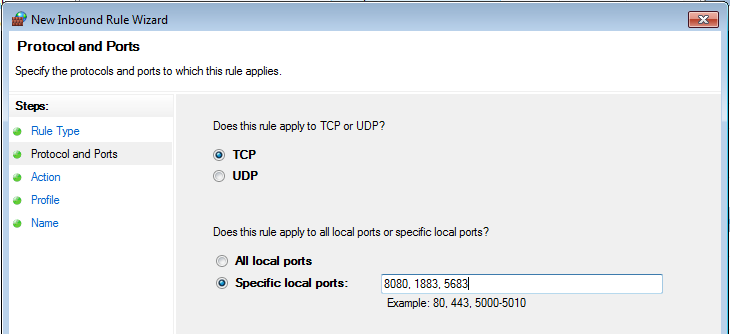
- On the “Action” step leave “Allow the connection” option selected:
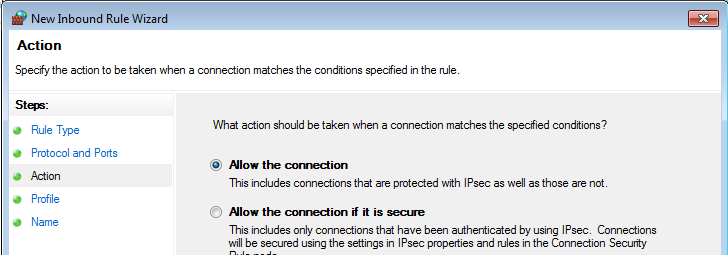
- On the “Profile” step select Windows network profiles when to apply this rule:
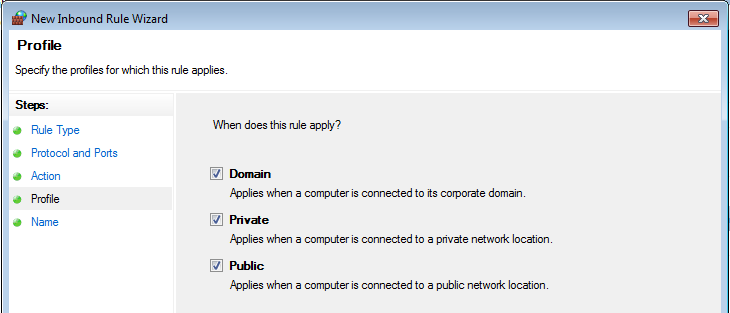
- Finally, give the name to this rule (for ex. “Trendz Service Networking”) and click “Finish”.
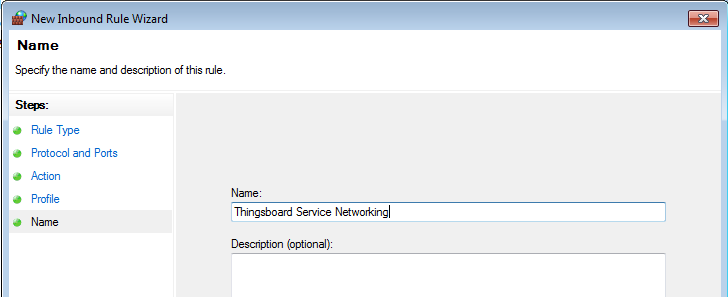
Next steps
-
Getting started guide - These guide provide quick overview of main Trendz features.
-
Metric Explorer - Learn how to explore and create new metrics with Trendz Metric Explorer.
-
Anomaly Detection - Learn how to identify anomalies in the data.
-
Calculated Fields - Learn about Calculated fields and how to use them.
-
States - Learn how to define and analyse states for assets based on raw telemetry.
-
Prediction - Learn how to make forecasts and predict telemetry behavior.
-
Filters - Learn how filter dataset during analysis.
-
Available Visualizations - Learn about visualization widgets available in Trendz and how to configure them.
-
Share and embed Visualizations - Learn how to add Trendz visualizations on ThingsBoard dashboard or 3rd party web pages.
-
AI Assistant - Learn how to utilize Trendz AI capabilities.